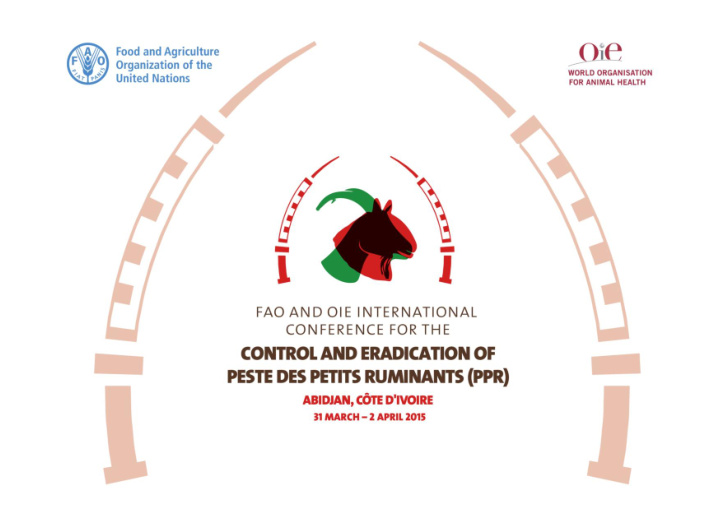



DR. AMEHA SEBSIBE HEAD, LIVESTOCK PROGRAM, ICPALD/IGAD REGIONAL FRAMEWORK FOR THE PROGRESSIVE CONTROL AND ERADICATION OF PESTE DES PETITS RUMINANTS (PPR) IN THE IGAD REGION
IGAD REGION
Background • Huge LS resources (about 520 million of which about 35% are small ruminants) • The region is also the leading exporter of live animals in Africa (8.6 Million ruminants exported to MENA in 2012) and of which the majority is small ruminants) • About 80% of the region fall under arid and semiarid areas and the predominant livestock production system is pastoral and agro pastoral • Seasonal mobility of animals in search of pasture & water is a common practice • PPR is one of the nine priority TADs identified in the region 4
Situation of PPR • Reported number of cases in 2008 – 12 (in all MS except Djibouti) 5
Situation… Ongoing Interventions Country Disease notifiable/ Vaccine Recent and ongoing interventions first reported production Djibouti Yes / not reported Passive surveillance & disease reporting Eritrea NI NI NI Ethiopia Yes /1977 Yes sero ‐ prevalence studies; vaccination in different agro ‐ pastoral ecosystems & surveillance; risk factors documented Kenya Yes / 2006 Yes Surveillance and outbreak investigations, vaccination and sero ‐ monitoring, livestock movement control, Somalia Yes / 1977 vaccinations S Sudan Yes / 1971 Vaccinations and outbreak response Sudan Yes/ 1971 Yes Surveillance (active & passive), vaccination & sero- monitoring, outbreak response, cross-boarder collaboration (S. Sudan & Ethiopia); field pilot studies on thermo-stable PPR vaccine delivery Uganda Yes /2007 Occasional vaccination (especially in Karamoja region). Research on Thermostable PPR vaccine and DIVA vaccine 6
The PPR Regional Framework • To coordinate harmonized control efforts in the region • A customized regional strategy aligned with the continental strategy developed by AU- IBAR and partners • The Global PPR strategy ? 7
The PPR RF…Objectives • The specific objective of this strategy is to progressively control and eradicate PPR in the IGAD region in order to enhance small ruminant productivity and production, and improve trade. • Depending on the priority of member states , PPR control and eradication will be combined with other control activities for CCPP, SGP, and brucellosis and the provision of therapeutic services for the control of ecto- and endo-parasites impacting on small ruminant productivity. 8
The PPR RF…Devt Process • The strategy developed by IGAD and AU-IBAR in collaboration with partners, with financial support from the EU and through the project - “improving animal disease surveillance in support of trade in the IGAD Member States (MS)”, • Development and validation was participatory through IGAD regional PPR technical committee (involved are MS, AU-IBAR, IGAD, FAO, OIE, ILRI) Regional PPR Control Coordination Committee (MS and partners ) 9
The PPR RF…Phases • The proposed strategy is based on a step-wise approach that integrates four sequential phases in line with the Pan-African Programme for the Progressive Control of PPR. • The four phases are : 1. Epidemiological and socio-economic assessment (2-3y) 2. Control (2-3 years ) 3. Eradication (2-3 years ) 4. Verification of absence of PPR and OIE accreditation of PPR free status (4-6 years) 10
The PPR RF…Tools • Develop regional roadmap countries to determine their stage in order to demonstrate how the region can move forward to eliminate PPR • Value chain and risk analysis the combination of value chain and qualitative epidemiological risk analysis will be used for planning and implementation of PPR control and eradication programmes. • Epidemiological surveillance Strengthening the national epidemiological capabilities 11
The PPR RF…Tools Cont’d • Diagnostic tests Ethiopia, Kenya, Sudan and Uganda have full capacities for PPR diagnosis (provide regional support in PPR diagnosis and training). Basic capacities on serological diagnosis are essential in all countries. • Vaccination and sero-monitoring need to assess the vaccine requirements for the IGAD region vis a vis the adopted vaccination strategy based on risk- targeting. The need for thermostable PPR vaccine to make it commercially available MS are encouraged to conduct sero-monitoring. 12
The PPR RF…Tools Cont’d • Multi-disease approach PPR vaccination programmes should be combined as much as possible with vaccinations against other national priority small ruminant diseases • Communication and awareness • Standard methods and procedures • Research • Public private partnerships • Capacity building • Emergency preparedness and contingency planning 13
Operationalization of the RF – Key Actions At national level • Development and or alignment of national PPR control and eradication strategies with the RF • Development of national PPR control and eradication programmes • Advocacy and resource mobilization • Establishment of national implementation and coordination unit • Development and implementation of the monitoring and evaluation framework 14
Operationalization… At regional level • Approval of the strategy IGAD council of Ministers IGAD summit • Partnerships and strategic alliances IGAD to partner and mobilize technical, financial and political support for implementation of the strategy • Resource mobilization • Development of Regional PPR Control & Eradication Program • Coordination • M&E 15
SR embarking for ME 16
Thank you Acknowledgments: EU, AUIBAR, MS, FAO, OIE, ILRI
Recommend
More recommend